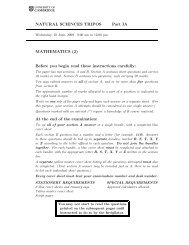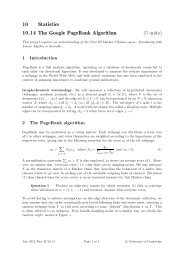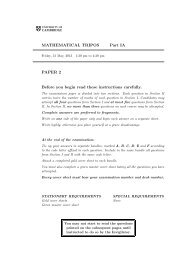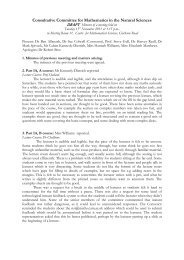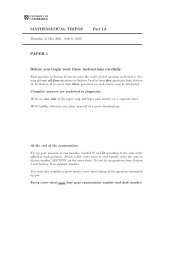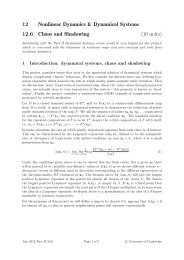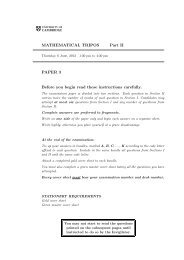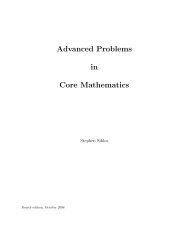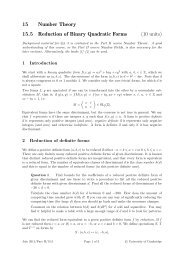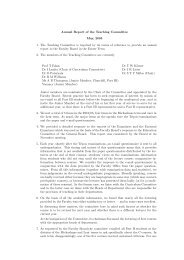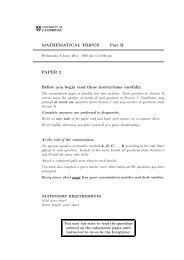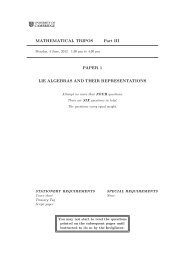MATHEMATICAL TRIPOS Part II PAPER 4 Before you begin read ...
MATHEMATICAL TRIPOS Part II PAPER 4 Before you begin read ...
MATHEMATICAL TRIPOS Part II PAPER 4 Before you begin read ...
- No tags were found...
Create successful ePaper yourself
Turn your PDF publications into a flip-book with our unique Google optimized e-Paper software.
<strong>MATHEMATICAL</strong> <strong>TRIPOS</strong><br />
<strong>Part</strong> <strong>II</strong><br />
Friday, 8 June, 2012<br />
9:00 am to 12:00 pm<br />
<strong>PAPER</strong> 4<br />
<strong>Before</strong> <strong>you</strong> <strong>begin</strong> <strong>read</strong> these instructions carefully.<br />
The examination paper is divided into two sections. Each question in Section <strong>II</strong><br />
carries twice the number of marks of each question in Section I. Candidates may<br />
attempt at most six questions from Section I and any number of questions from<br />
Section <strong>II</strong>.<br />
Complete answers are preferred to fragments.<br />
Write on one side of the paper only and <strong>begin</strong> each answer on a separate sheet.<br />
Write legibly; otherwise <strong>you</strong> place <strong>you</strong>rself at a grave disadvantage.<br />
At the end of the examination:<br />
Tie up <strong>you</strong>r answers in bundles, marked A, B, C, . . ., K according to the code letter<br />
affixed to each question. Include in the same bundle all questions from Sections I<br />
and <strong>II</strong> with the same code letter.<br />
Attach a completed gold cover sheet to each bundle.<br />
You must also complete a green master cover sheet listing all the questions <strong>you</strong> have<br />
attempted.<br />
Every cover sheet must bear <strong>you</strong>r examination number and desk number.<br />
STATIONERY REQUIREMENTS<br />
Gold cover sheet<br />
Green master cover sheet<br />
You may not start to <strong>read</strong> the questions<br />
printed on the subsequent pages until<br />
instructed to do so by the Invigilator.
2<br />
SECTION I<br />
1I Number Theory<br />
Define what it means for the composite natural number N to be a pseudoprime to<br />
the base b.<br />
Find the number of bases (less than 21) to which 21 is a pseudoprime. [You may, if<br />
<strong>you</strong> wish, assume the Chinese Remainder Theorem.]<br />
2F Topics in Analysis<br />
Let A 1 , A 2 , . . . , A n be real numbers and suppose that x 1 , x 2 , . . . , x n ∈ [−1, 1] are distinct.<br />
Suppose that the formula<br />
∫ 1<br />
n∑<br />
p(x) dx = A j p(x j )<br />
−1<br />
is valid for every polynomial p of degree 2n − 1. Prove the following:<br />
(i) A j > 0 for each j = 1, 2, . . . , n.<br />
(ii) ∑ n<br />
j=1 A j = 2.<br />
(iii) x 1 , x 2 , . . . , x n are the roots of the Legendre polynomial of degree n.<br />
[You may assume standard orthogonality properties of the Legendre polynomials.]<br />
j=1<br />
3G<br />
Geometry and Groups<br />
Explain briefly how to extend a Möbius transformation<br />
T : z ↦→ az + b<br />
cz + d<br />
with ad − bc = 1<br />
from the boundary of the upper half-space R 3 + to give a hyperbolic isometry ˜T of the<br />
upper half-space. Write down explicitly the extension of the transformation z ↦→ λ 2 z for<br />
any constant λ ∈ C \ {0}.<br />
Show that, if ˜T has an axis, which is a hyperbolic line that is mapped onto itself<br />
by ˜T with the orientation preserved, then ˜T moves each point of this axis by the same<br />
hyperbolic distance, l say. Prove that<br />
∣<br />
l = 2<br />
∣∣<br />
∣ log 1<br />
2<br />
(<br />
a + d + √ (a + d) 2 − 4)∣ ∣∣<br />
∣ ∣∣∣<br />
.<br />
<strong>Part</strong> <strong>II</strong>, Paper 4
4G<br />
Coding and Cryptography<br />
Describe the BB84 protocol for quantum key exchange.<br />
3<br />
Suppose we attempt to implement the BB84 protocol but cannot send single<br />
photons. Instead we send K photons at a time all with the same polarization. An enemy<br />
can separate one of these photons from the other K − 1. Explain briefly how the enemy<br />
can intercept the key exchange without our knowledge.<br />
Show that an enemy can find our common key if K = 3. Can she do so when K = 2<br />
(with suitable equipment)<br />
5K Statistical Modelling<br />
Define the concepts of an exponential dispersion family and the corresponding<br />
variance function. Show that the family of Poisson distributions with parameter λ > 0<br />
is an exponential dispersion family. Find the corresponding variance function and deduce<br />
from it expressions for E(Y ) and Var(Y ) when Y ∼ Pois(λ). What is the canonical link<br />
function in this case<br />
6C Mathematical Biology<br />
The master equation describing the evolution of the probability P (n, t) that a<br />
population has n members at time t takes the form<br />
∂P (n, t)<br />
∂t<br />
= b(n − 1)P (n − 1, t) − [b(n) + d(n)]P (n, t) + d(n + 1)P (n + 1, t) , (1)<br />
where the functions b(n) and d(n) are both positive for all n.<br />
From (1) derive the corresponding Fokker–Planck equation in the form<br />
∂P (x, t)<br />
∂t<br />
∂ 2<br />
= − ∂<br />
∂x {a 1(x)P (x, t)} + 1 2<br />
∂x 2 {a 2(x)P (x, t)} , (2)<br />
making clear any assumptions that <strong>you</strong> make and giving explicit forms for a 1 (x) and a 2 (x).<br />
Assume that (2) has a steady state solution P s (x) and that a 1 (x) is a decreasing<br />
function of x with a single zero at x 0 . Under what circumstances may P s (x) be<br />
approximated by a Gaussian centred at x 0 and what is the corresponding estimate of<br />
the variance<br />
<strong>Part</strong> <strong>II</strong>, Paper 4<br />
[TURN OVER
4<br />
7D Dynamical Systems<br />
Describe the different types of bifurcation from steady states of a one-dimensional<br />
map of the form x n+1 = f(x n ), and give examples of simple equations exhibiting each<br />
type.<br />
Consider the map x n+1 = αx 2 n (1 − x n), 0 < x n < 1. What is the maximum value of<br />
α for which the interval is mapped into itself<br />
Show that as α increases from zero to its maximum value there is a saddle-node<br />
bifurcation and a period-doubling bifurcation, and determine the values of α for which<br />
they occur.<br />
8E Further Complex Methods<br />
Use the Laplace kernel method to write integral representations in the complex<br />
t-plane for two linearly independent solutions of the confluent hypergeometric equation<br />
z d2 w(z)<br />
dz 2<br />
+ (c − z) dw(z)<br />
dz<br />
− aw(z) = 0 ,<br />
in the case that Re(z) > 0, Re(c) > Re(a) > 0, a and c − a are not integers.<br />
9A Classical Dynamics<br />
Consider a one-dimensional dynamical system with generalized coordinate and<br />
momentum (q, p).<br />
(a) Define the Poisson bracket {f, g} of two functions f(q, p, t) and g(q, p, t).<br />
(b) Find the Poisson brackets {q, q}, {p, p} and {q, p}.<br />
(c) Assuming Hamilton’s equations of motion prove that<br />
df<br />
dt<br />
= {f, H} +<br />
∂f<br />
∂t .<br />
(d) State the condition for a transformation (q, p) → (Q, P ) to be canonical in terms of<br />
the Poisson brackets found in (b). Use this to determine whether or not the following<br />
transformations are canonical:<br />
(i) Q = sin q, P = p−a<br />
cos q ,<br />
(ii) Q = cos q, P = p−a<br />
sin q ,<br />
where a is constant.<br />
<strong>Part</strong> <strong>II</strong>, Paper 4
5<br />
10E Cosmology<br />
The number density of a species ⋆ of non-relativistic particles of mass m, in<br />
equilibrium at temperature T and chemical potential µ, is<br />
n ⋆ = g ⋆<br />
( 2πmkT<br />
h 2 ) 3/2<br />
e (µ−mc2 )/kT ,<br />
where g ⋆ is the spin degeneracy. During primordial nucleosynthesis, deuterium, D, forms<br />
through the nuclear reaction<br />
p + n ↔ D ,<br />
where p and n are non-relativistic protons and neutrons.<br />
between the chemical potentials in equilibrium.<br />
Write down the relationship<br />
Using the fact that g D = 4, and explaining the approximations <strong>you</strong> make, show that<br />
(<br />
n D h<br />
2<br />
) 3/2 ( )<br />
BD<br />
≈<br />
exp ,<br />
n n n p πm p kT<br />
kT<br />
where B D is the deuterium binding energy, i.e. B D = (m n + m p − m D )c 2 .<br />
Let X ⋆ = n ⋆ /n B where n B is the baryon number density of the universe. Using the<br />
fact that n γ ∝ T 3 , show that<br />
( )<br />
X D<br />
∝ T 3/2 BD<br />
η exp ,<br />
X n X p kT<br />
where η is the baryon asymmetry parameter<br />
η = n B<br />
n γ<br />
.<br />
Briefly explain why primordial deuterium does not form until temperatures well below<br />
kT ∼ B D .<br />
<strong>Part</strong> <strong>II</strong>, Paper 4<br />
[TURN OVER
6<br />
SECTION <strong>II</strong><br />
11I<br />
Number Theory<br />
Let f : N → R be a function, where N denotes the (positive) natural numbers.<br />
Define what it means for f to be a multiplicative function.<br />
Prove that if f is a multiplicative function, then the function g : N → R defined by<br />
g(n) = ∑ d|n<br />
f(d)<br />
is also multiplicative.<br />
Define the Möbius function µ. Is µ multiplicative Briefly justify <strong>you</strong>r answer.<br />
Compute<br />
for all positive integers n.<br />
∑<br />
µ(d)<br />
d|n<br />
Define the Riemann zeta function ζ for complex numbers s with R(s) > 1.<br />
Prove that if s is a complex number with R(s) > 1, then<br />
1<br />
∞<br />
ζ(s) = ∑<br />
n=1<br />
µ(n)<br />
n s .<br />
12G Geometry and Groups<br />
Define the Hausdorff dimension of a subset of the Euclidean plane.<br />
Let ∆ be a closed disc of radius r 0 in the Euclidean plane. Define a sequence of<br />
sets K n ⊆ ∆, n = 1, 2, . . . , as follows: K 1 = ∆ and for each n 1 a subset K n+1 ⊂ K n is<br />
produced by replacing each component disc Γ of K n by three disjoint, closed discs inside Γ<br />
with radius at most c n times the radius of Γ. Let K be the intersection of the sets K n .<br />
Show that if the factors c n converge to a limit c with 0 < c < 1, then the Hausdorff<br />
dimension of K is at most log 1 3 / log c. <strong>Part</strong> <strong>II</strong>, Paper 4
7<br />
13K Statistical Modelling<br />
Let (X 1 , Y 1 ), . . . , (X n , Y n ) be jointly independent and identically distributed with<br />
X i ∼ N(0, 1) and conditional on X i = x, Y i ∼ N(xθ, 1), i = 1, 2, . . . , n.<br />
(a) Write down the likelihood of the data (X 1 , Y 1 ), . . . , (X n , Y n ), and find the maximum<br />
likelihood estimate ˆθ of θ. [You may use properties of conditional probability/expectation<br />
without providing a proof.]<br />
(b) Find the Fisher information I(θ) for a single observation, (X 1 , Y 1 ).<br />
(c) Determine the limiting distribution of √ n(ˆθ − θ). [You may use the result on<br />
the asymptotic distribution of maximum likelihood estimators, without providing a<br />
proof.]<br />
(d) Give an asymptotic confidence interval for θ with coverage (1−α) using <strong>you</strong>r answers<br />
to (b) and (c).<br />
(e) Define the observed Fisher information. Compare the confidence interval in part (d)<br />
with an asymptotic confidence interval with coverage (1 − α) based on the observed<br />
Fisher information.<br />
(f) Determine the exact distribution of (∑ n<br />
) 1/2<br />
i=1 X2 i (ˆθ − θ) and find the true coverage<br />
probability for the interval in part (e). [Hint. Condition on X 1 , X 2 , . . . , X n and<br />
use the following property of conditional expectation: for U, V random vectors, any<br />
suitable function g, and x ∈ R,<br />
P {g(U, V ) x} = E[P {g(U, V ) x|V }].]<br />
14D Dynamical Systems<br />
What is meant by the statement that a continuous map of an interval I into itself<br />
has a horseshoe State without proof the properties of such a map.<br />
Define the property of chaos of such a map according to Glendinning.<br />
A continuous map f : I → I has a periodic orbit of period 5, in which the elements<br />
x j , j = 1, . . . , 5 satisfy x j < x j+1 , j = 1, . . . , 4 and the points are visited in the order<br />
x 1 → x 3 → x 4 → x 2 → x 5 → x 1 . Show that the map is chaotic. [The Intermediate Value<br />
theorem can be used without proof.]<br />
<strong>Part</strong> <strong>II</strong>, Paper 4<br />
[TURN OVER
8<br />
15A Classical Dynamics<br />
A homogenous thin rod of mass M and length l is constrained to rotate in a<br />
horizontal plane about its centre O. A bead of mass m is set to slide along the rod<br />
without friction. The bead is attracted to O by a force resulting in a potential kx 2 /2,<br />
where x is the distance from O.<br />
(a) Identify suitable generalized coordinates and write down the Lagrangian of the system.<br />
(b) Identify all conserved quantities.<br />
(c) Derive the equations of motion and show that one of them can be written as<br />
mẍ = − ∂V eff(x)<br />
∂x<br />
where the form of the effective potential V eff (x) should be found explicitly.<br />
(d) Sketch the effective potential. Find and characterize all points of equilibrium.<br />
(e) Find the frequencies of small oscillations around the stable equilibria.<br />
,<br />
16H Logic and Set Theory<br />
State and prove Hartogs’ lemma. [You may assume the result that any well-ordered<br />
set is isomorphic to a unique ordinal.]<br />
Let a and b be sets such that there is a bijection a ⊔ b → a × b. Show, without<br />
assuming the Axiom of Choice, that there is either a surjection b → a or an injection<br />
b → a. By setting b = γ(a) (the Hartogs ordinal of a) and considering (a ⊔ b) × (a ⊔ b),<br />
show that the assertion ‘For all infinite cardinals m, we have m 2 = m’ implies the Axiom<br />
of Choice. [You may assume the Cantor–Bernstein theorem.]<br />
<strong>Part</strong> <strong>II</strong>, Paper 4
9<br />
17F Graph Theory<br />
(a) Show that every finite tree of order at least 2 has a leaf. Hence, or otherwise,<br />
show that a tree of order n 1 must have precisely n − 1 edges.<br />
(b) Let G be a graph. Explain briefly why |G|/α(G) χ(G) ∆(G) + 1.<br />
Let k = χ(G), and assume k 2. By induction on |G|, or otherwise, show that G<br />
has a subgraph H with δ(H) k − 1. Hence, or otherwise, show that if T is a tree of<br />
order k then T ⊆ G.<br />
(c) Let s, t 2 be integers, let n = (s − 1)(t − 1) + 1 and let T be a tree of order<br />
t. Show that whenever the edges of the complete graph K n are coloured blue and yellow<br />
then it must contain either a blue K s or a yellow T .<br />
Does this remain true if K n is replaced by K n−1 Justify <strong>you</strong>r answer.<br />
[The independence number α(G) of a graph G is the size of the largest set W ⊆ V (G)<br />
of vertices such that no edge of G joins two points of W . Recall that χ(G) is the chromatic<br />
number and δ(G), ∆(G) are respectively the minimal/maximal degrees of vertices in G. ]<br />
18H Galois Theory<br />
Let F = C(X 1 , . . . , X n ) be a field of rational functions in n variables over C, and<br />
let s 1 , . . . , s n be the elementary symmetric polynomials:<br />
∑<br />
s j :=<br />
X i1 · · · X ij ∈ F (1 j n) ,<br />
{i 1 ,...,i j }⊂{1,...,n}<br />
and let K = C(s 1 , . . . , s n ) be the subfield of F generated by s 1 , . . . , s n . Let 1 m n,<br />
and Y := X 1 + · · · + X m ∈ F . Let K(Y ) be the subfield of F generated by Y over K.<br />
Find the degree [K(Y ) : K].<br />
[Standard facts about the fields F, K and Galois extensions can be quoted without proof,<br />
as long as they are clearly stated.]<br />
19H Representation Theory<br />
Write an essay on the finite-dimensional representations of SU(2), including a proof<br />
of their complete reducibility, and a description of the irreducible representations and the<br />
decomposition of their tensor products.<br />
<strong>Part</strong> <strong>II</strong>, Paper 4<br />
[TURN OVER
10<br />
20F Number Fields<br />
Let K = Q( √ p, √ q) where p and q are distinct primes with p ≡ q ≡ 3 (mod 4). By<br />
computing the relative traces Tr K/k (θ) where k runs through the three quadratic subfields<br />
of K, show that the algebraic integers θ in K have the form<br />
θ = 1 2 (a + b√ p) + 1 2 (c + d√ p) √ q ,<br />
where a, b, c, d are rational integers. Show further that if c and d are both even then a and<br />
b are both even. Hence prove that an integral basis for K is<br />
1 ,<br />
Calculate the discriminant of K.<br />
√ p ,<br />
1 + √ pq<br />
2<br />
,<br />
√ √ p + q<br />
.<br />
2<br />
21G Algebraic Topology<br />
State and prove the Lefschetz fixed-point theorem. Hence show that the n-sphere<br />
S n does not admit a topological group structure for any even n > 0. [The existence and<br />
basic properties of simplicial homology with rational coefficients may be assumed.]<br />
<strong>Part</strong> <strong>II</strong>, Paper 4
11<br />
22G Linear Analysis<br />
Let X be a Banach space and suppose that T : X → X is a bounded linear operator.<br />
What is an eigenvalue of T What is the spectrum σ(T ) of T <br />
Let X = C[0, 1] be the space of continuous real-valued functions f : [0, 1] → R<br />
endowed with the sup norm. Define an operator T : X → X by<br />
where<br />
T f(x) =<br />
G(x, y) =<br />
Prove the following facts about T :<br />
∫ 1<br />
0<br />
G(x, y)f(y) dy,<br />
{<br />
y(x − 1) if y x,<br />
x(y − 1) if x y.<br />
(i) T f(0) = T f(1) = 0 and the second derivative (T f) ′′ (x) is equal to f(x) for x ∈ (0, 1);<br />
(ii) T is compact;<br />
(iii) T has infinitely many eigenvalues;<br />
(iv) 0 is not an eigenvalue of T ;<br />
(v) 0 ∈ σ(T ).<br />
[The Arzelà–Ascoli theorem may be assumed without proof.]<br />
23I Algebraic Geometry<br />
Let X be a smooth projective curve of genus 2, defined over the complex numbers.<br />
Show that there is a morphism f : X → P 1 which is a double cover, ramified at six points.<br />
Explain briefly why X cannot be embedded into P 2 .<br />
For any positive integer n, show that there is a smooth affine plane curve which is<br />
a double cover of A 1 ramified at n points.<br />
[State clearly any theorems that <strong>you</strong> use.]<br />
<strong>Part</strong> <strong>II</strong>, Paper 4<br />
[TURN OVER
12<br />
24I Differential Geometry<br />
For manifolds X, Y ⊂ R n , define the terms tangent space to X at a point x ∈ X<br />
and derivative df x of a smooth map f : X → Y . State the Inverse Function Theorem for<br />
smooth maps between manifolds without boundary.<br />
Now let X be a submanifold of Y and f : X → Y the inclusion map. By considering<br />
the map f −1 : f(X) → X, or otherwise, show that df x is injective for each x ∈ X.<br />
Show further that there exist local coordinates around x and around y = f(x) such<br />
that f is given in these coordinates by<br />
(x 1 , . . . , x l ) ∈ R l ↦→ (x 1 , . . . , x l , 0, . . . , 0) ∈ R k ,<br />
where l = dim X and k = dim Y . [You may assume that any open ball in R l is<br />
diffeomorphic to R l .]<br />
25J<br />
Probability and Measure<br />
State and prove Fatou’s lemma. [You may use the monotone convergence theorem.]<br />
For (E, E, µ) a measure space, define L 1 := L 1 (E, E, µ) to be the vector space of µ-<br />
integrable functions on E, where functions equal almost everywhere are identified. Prove<br />
that L 1 is complete for the norm ‖ · ‖ 1 ,<br />
∫<br />
‖f‖ 1 := |f|dµ, f ∈ L 1 .<br />
E<br />
[You may assume that ‖ · ‖ 1 indeed defines a norm on L 1 .] Give an example of a measure<br />
space (E, E, µ) and of a sequence f n ∈ L 1 that converges to f almost everywhere such that<br />
f /∈ L 1 .<br />
Now let<br />
∫<br />
D := {f ∈ L 1 : f 0 almost everywhere , fdµ = 1} .<br />
E<br />
If a sequence f n ∈ D converges to f in L 1 , does it follow that f ∈ D If f n ∈ D converges<br />
to f almost everywhere, does it follow that f ∈ D Justify <strong>you</strong>r answers.<br />
<strong>Part</strong> <strong>II</strong>, Paper 4
13<br />
26K Applied Probability<br />
(a) Define the Moran model and Kingman’s n-coalescent. State and prove a theorem<br />
which describes the relationship between them. [You may use without proof a construction<br />
of the Moran model for all −∞ < t < ∞.]<br />
(b) Let θ > 0. Suppose that a population of N 2 individuals evolves according<br />
to the rules of the Moran model. Assume also that each individual in the population<br />
undergoes a mutation at constant rate u = θ/(N − 1). Each time a mutation occurs, we<br />
assume that the allelic type of the corresponding individual changes to an entirely new<br />
type, never seen before in the population. Let p(θ) be the homozygosity probability, i.e.,<br />
the probability that two individuals sampled without replacement from the population<br />
have the same genetic type. Give an expression for p(θ).<br />
(c) Let q(θ) denote the probability that a sample of size n consists of one allelic<br />
type (monomorphic population). Show that q(θ) = E(exp{−(θ/2)L n }), where L n denotes<br />
the sum of all the branch lengths in the genealogical tree of the sample — that is,<br />
L n = ∑ n<br />
i=2 i(τ i − τ i−1 ), where τ i is the first time that the genealogical tree of the sample<br />
has i lineages. Deduce that<br />
(n − 1)!<br />
q(θ) = ∏ n−1<br />
.<br />
i=1 (θ + i)<br />
27K Principles of Statistics<br />
For i = 1, . . . , n, the pairs (X i , Y i ) have independent bivariate normal distributions,<br />
with E(X i ) = µ X , E(Y i ) = µ Y , var(X i ) = var(Y i ) = φ, and corr(X i , Y i ) = ρ. The means<br />
µ X , µ Y are known; the parameters φ > 0 and ρ ∈ (−1, 1) are unknown.<br />
Show that the joint distribution of all the variables belongs to an exponential family,<br />
and identify the natural sufficient statistic, natural parameter, and mean-value parameter.<br />
Hence or otherwise, find the maximum likelihood estimator ˆρ of ρ.<br />
Let U i := X i + Y i , V i := X i − Y i . What is the joint distribution of (U i , V i )<br />
Show that the distribution of<br />
(1 + ˆρ)/(1 − ˆρ)<br />
(1 + ρ)/(1 − ρ)<br />
is Fn n . Hence describe a (1 − α)-level confidence interval for ρ. Briefly explain what would<br />
change if µ X and µ Y were also unknown.<br />
[Recall that the distribution F ν 1<br />
ν 2<br />
is that of (W 1 /ν 1 )/(W 2 /ν 2 ), where, independently for<br />
j = 1 and j = 2, W j has the chi-squared distribution with ν j degrees of freedom.]<br />
<strong>Part</strong> <strong>II</strong>, Paper 4<br />
[TURN OVER
14<br />
28J Optimization and Control<br />
A factory has a tank of capacity 3 m 3 in which it stores chemical waste. Each week<br />
the factory produces, independently of other weeks, an amount of waste that is equally<br />
likely to be 0, 1, or 2 m 3 . If the amount of waste exceeds the remaining space in the tank<br />
then the excess must be specially handled at a cost of £C per m 3 . The tank may be<br />
emptied or not at the end of each week. Emptying costs £D, plus a variable cost of £α<br />
for each m 3 of its content. It is always emptied when it ends the week full.<br />
It is desired to minimize the average cost per week. Write down equations from<br />
which one can determine when it is optimal to empty the tank.<br />
Find the average cost per week of a policy π, which empties the tank if and only if<br />
its content at the end of the week is 2 or 3 m 3 .<br />
Describe the policy improvement algorithm. Explain why, starting from π, this<br />
algorithm will find an optimal policy in at most three iterations.<br />
Prove that π is optimal if and only if C α + (4/3)D.<br />
29J Stochastic Financial Models<br />
In a one-period market, there are n risky assets whose returns at time 1 are given<br />
by a column vector R = ( R 1 , . . . , R n) ′ . The return vector R has a multivariate Gaussian<br />
distribution with expectation µ and non-singular covariance matrix V. In addition, there<br />
is a bank account giving interest r > 0, so that one unit of cash invested at time 0 in the<br />
bank account will be worth R f = 1 + r units of cash at time 1.<br />
An agent with the initial wealth w invests x = (x 1 , . . . , x n ) ′ in risky assets and keeps<br />
the remainder x 0 = w − x · 1 in the bank account. The return on the agent’s portfolio is<br />
Z := x · R + (w − x · 1)R f .<br />
The agent’s utility function is u(Z) = − exp(−γZ), where γ > 0 is a parameter.<br />
His objective is to maximize E(u(Z)).<br />
(i) Find the agent’s optimal portfolio and its expected return.<br />
[Hint. Relate E(u(Z)) to E(Z) and Var(Z).]<br />
(ii) Under which conditions does the optimal portfolio that <strong>you</strong> found in (i) require<br />
borrowing from the bank account<br />
(iii) Find the optimal portfolio if it is required that all of the agent’s wealth be<br />
invested in risky assets.<br />
<strong>Part</strong> <strong>II</strong>, Paper 4
15<br />
30B <strong>Part</strong>ial Differential Equations<br />
i) State the Lax–Milgram lemma.<br />
ii) Consider the boundary value problem<br />
∆ 2 u − ∆u + u = f in Ω,<br />
u = ∇u · γ = 0<br />
on ∂Ω,<br />
where Ω is a bounded domain in R n with a smooth boundary, γ is the exterior unit normal<br />
vector to ∂Ω, and f ∈ L 2 (Ω). Show (using the Lax–Milgram lemma) that the boundary<br />
value problem has a unique weak solution in the space<br />
[Hint. Show that<br />
H 2 0 (Ω) := { u : Ω → R; u = ∇u · γ = 0 on ∂Ω } .<br />
n∑<br />
‖∆u‖ 2 L 2 (Ω) =<br />
∥<br />
∂2 u<br />
∥ ∥∥<br />
2<br />
∂x i ∂x j<br />
i,j=1<br />
L 2 (Ω)<br />
for all u ∈ C ∞ 0 (Ω),<br />
and then use the fact that C ∞ 0 (Ω) is dense in H2 0 (Ω).]<br />
<strong>Part</strong> <strong>II</strong>, Paper 4<br />
[TURN OVER
16<br />
31B<br />
Asymptotic Methods<br />
The stationary Schrödinger equation in one dimension has the form<br />
ǫ 2 d2 ψ<br />
= −(E − V (x)) ψ,<br />
dx2 where ǫ can be assumed to be small. Using the Liouville–Green method, show that two<br />
approximate solutions in a region where V (x) < E are<br />
1<br />
ψ(x) ∼<br />
{±<br />
(E − V (x)) 1/4 exp i ∫ x<br />
}<br />
(E − V (x ′ )) 1/2 dx ′ ,<br />
ǫ<br />
where c is suitably chosen.<br />
Without deriving connection formulae in detail, describe how one obtains the<br />
condition<br />
∫<br />
1 b<br />
(<br />
(E − V (x ′ )) 1/2 dx ′ = n + 1 )<br />
π<br />
(∗)<br />
ǫ<br />
2<br />
a<br />
for the approximate energies E of bound states in a smooth potential well.<br />
appropriate values of a, b and n.<br />
c<br />
State the<br />
Estimate the range of n for which (∗) gives a good approximation to the true bound<br />
state energies in the cases<br />
(i) V (x) = |x|,<br />
(ii) V (x) = x 2 + λx 6 with λ small and positive,<br />
(iii) V (x) = x 2 − λx 6 with λ small and positive.<br />
<strong>Part</strong> <strong>II</strong>, Paper 4
17<br />
32A Principles of Quantum Mechanics<br />
Setting = 1, the raising and lowering operators J ± = J 1 ± iJ 2 for angular<br />
momentum satisfy<br />
[J 3 , J ± ] = ±J ± , J ± |j m〉 = √ (j ∓ m)(j ± m + 1) |j m ± 1〉 ,<br />
where J 3 |j m〉 = m|j m〉. Find the matrix representation S ± for J ± in the basis<br />
{|1 1〉, |1 0〉, |1 − 1〉} of j = 1 states. Hence, calculate the matrix representation S of J.<br />
Suppose that the angular momentum of the state v = |1 m〉 is measured in the<br />
direction n = (0, sin θ, cos θ) to be +1. Find the components of v, expressing each<br />
component by a single term consisting of products of powers of sin(θ/2) and cos(θ/2)<br />
multiplied by constants.<br />
Suppose that two measurements of a total angular momentum 1 system are made.<br />
The first is made in the third direction with value +1, and the second measurement is<br />
subsequently immediately made in direction n. What is the probability that the second<br />
measurement is also +1<br />
<strong>Part</strong> <strong>II</strong>, Paper 4<br />
[TURN OVER
18<br />
33E Applications of Quantum Mechanics<br />
Consider a one-dimensional crystal lattice of lattice spacing a with the n-th atom<br />
having position r n = na+x n and momentum p n , for n = 0, 1, . . . , N−1. The atoms interact<br />
with their nearest neighbours with a harmonic force and the classical Hamiltonian is<br />
H = ∑ n<br />
p 2 n<br />
2m + 1 2 λ(x n − x n−1 ) 2 ,<br />
where we impose periodic boundary conditions: x N = x 0 . Show that the normal mode<br />
frequencies for the classical harmonic vibrations of the system are given by<br />
√ ( )∣ λ ω l = 2<br />
m ∣ sin kl a ∣∣∣<br />
,<br />
2<br />
where k l = 2πl/Na, with l integer and (for N even, which <strong>you</strong> may assume) −N/2 < l <br />
N/2. What is the velocity of sound in this crystal<br />
Show how the system may be quantized to give the quantum operator<br />
x n (t) = X 0 (t) + ∑ √<br />
<br />
[<br />
] a l e −i(ω lt−k l na) + a †<br />
2Nmω<br />
l ei(ω lt−k l na)<br />
,<br />
l<br />
l≠0<br />
where a † l and a l are creation and annihilation operators, respectively, whose commutation<br />
relations should be stated. Briefly describe the spectrum of energy eigenstates for this<br />
system, stating the definition of the ground state |0〉 and giving the expression for the<br />
energy eigenvalue of any eigenstate.<br />
The Debye–Waller factor e −W (Q) associated with Bragg scattering from this crystal<br />
is defined by the matrix element<br />
e −W (Q) = 〈0|e iQx 0(0) |0〉 .<br />
In the case where 〈0|X 0 |0〉 = 0, calculate W (Q).<br />
<strong>Part</strong> <strong>II</strong>, Paper 4
19<br />
34C Statistical Physics<br />
Non-relativistic electrons of mass m are confined to move in a two-dimensional plane<br />
of area A. Each electron has two spin states. Compute the density of states g(E) and<br />
show that it is constant.<br />
Write down expressions for the number of particles N and the average energy 〈E〉<br />
of a gas of fermions in terms of the temperature T and chemical potential µ. Find an<br />
expression for the Fermi Energy E F in terms of N.<br />
For k B T ≪ E F , <strong>you</strong> may assume that the chemical potential does not change with<br />
temperature. Compute the low temperature heat capacity of a gas of fermions. [You may<br />
use the approximation that, for large z,<br />
∫ ∞<br />
0<br />
x n dx<br />
z −1 e x + 1 ≈ 1<br />
n + 1 (log z)n+1 + π2 n<br />
6 (log z)n−1 .]<br />
35B Electrodynamics<br />
The charge and current densities are given by ρ(t, x) ≠ 0 and j(t, x) respectively.<br />
The electromagnetic scalar and vector potentials are given by φ(t, x) and A(t, x) respectively.<br />
Explain how one can regard j µ = (ρ, j) as a four-vector that obeys the current<br />
conservation rule ∂ µ j µ = 0.<br />
In the Lorenz gauge ∂ µ A µ = 0, derive the wave equation that relates A µ = (φ, A)<br />
to j µ and hence show that it is consistent to treat A µ as a four-vector.<br />
In the Lorenz gauge, with j µ = 0, a plane wave solution for A µ is given by<br />
where ǫ µ , k µ and x µ are four-vectors with<br />
Show that k µ k µ = k µ ǫ µ = 0.<br />
A µ = ǫ µ exp(ik ν x ν ) ,<br />
ǫ µ = (ǫ 0 , ǫ), k µ = (k 0 , k), x µ = (t, x) .<br />
Interpret the components of k µ in terms of the frequency and wavelength of the<br />
wave.<br />
Find what residual gauge freedom there is and use it to show that it is possible to<br />
set ǫ 0 = 0. What then is the physical meaning of the components of ǫ<br />
An observer at rest in a frame S measures the angular frequency of a plane wave<br />
travelling parallel to the z-axis to be ω. A second observer travelling at velocity v in S<br />
parallel to the z-axis measures the radiation to have frequency ω ′ . Express ω ′ in terms<br />
of ω.<br />
<strong>Part</strong> <strong>II</strong>, Paper 4<br />
[TURN OVER
20<br />
36B General Relativity<br />
The metric for a homogenous isotropic universe, in comoving coordinates, can be<br />
written as<br />
ds 2 = −dt 2 + a 2 {dr 2 + f 2 [dθ 2 + sin 2 θ dφ 2 ]} ,<br />
where a = a(t) and f = f(r) are some functions.<br />
Write down expressions for the Hubble parameter H and the deceleration parameter<br />
q in terms of a(η) and h ≡ d log a/dη, where η is conformal time, defined by dη = a −1 dt.<br />
The universe is composed of a perfect fluid of density ρ and pressure p = (γ − 1)ρ,<br />
where γ is a constant. Defining Ω = ρ/ρ c , where ρ c = 3H 2 /8πG, show that<br />
k<br />
h 2 = Ω − 1 , q = αΩ , dΩ<br />
= 2qh(Ω − 1) ,<br />
dη<br />
where k is the curvature parameter (k = +1, 0 or −1) and α ≡ 1 2<br />
(3γ − 2). Hence deduce<br />
that<br />
dΩ<br />
da = 2α Ω(Ω − 1)<br />
a<br />
and<br />
Ω =<br />
where A is a constant. Given that A =<br />
when γ > 2/3.<br />
1<br />
1 − Aa 2α ,<br />
k , sketch curves of Ω against a in the case<br />
2GM<br />
[You may assume an Einstein equation, for the given metric, in the form<br />
and the energy conservation equation<br />
dρ<br />
dt<br />
h 2<br />
a 2 + k a 2 = 8 3 πGρ<br />
+ 3H(ρ + p) = 0 .]<br />
37C Fluid Dynamics <strong>II</strong><br />
A steady, two-dimensional flow in the region y > 0 takes the form (u, v) =<br />
(Ex, −Ey) at large y, where E is a positive constant. The boundary at y = 0 is rigid<br />
and no-slip. Consider the velocity field u = ∂ψ/∂y, v = −∂ψ/∂x with stream function<br />
ψ = Exδf(η), where η = y/δ and δ = (ν/E) 1/2 and ν is the kinematic viscosity. Show<br />
that this velocity field satisfies the Navier–Stokes equations provided that f(η) satisfies<br />
f ′′′ + ff ′′ − (f ′ ) 2 = −1 .<br />
What are the conditions on f at η = 0 and as η → ∞<br />
<strong>Part</strong> <strong>II</strong>, Paper 4
21<br />
38D Waves<br />
The shallow-water equations<br />
∂h<br />
∂t + u∂h ∂x + h∂u ∂x = 0,<br />
∂u<br />
∂t + u∂u ∂x + g ∂h<br />
∂x = 0<br />
describe one-dimensional flow in a channel with depth h(x, t) and velocity u(x, t), where<br />
g is the acceleration due to gravity.<br />
(i) Find the speed c(h) of linearized waves on fluid at rest and of uniform depth.<br />
(ii) Show that the Riemann invariants u ± 2c are constant on characteristic curves<br />
C ± of slope u ± c in the (x, t)-plane.<br />
(iii) Use the shallow-water equations to derive the equation of momentum conservation<br />
∂(hu)<br />
+ ∂I<br />
∂t ∂x = 0 ,<br />
and identify the horizontal momentum flux I.<br />
(iv) A hydraulic jump propagates at constant speed along a straight constant-width<br />
channel. Ahead of the jump the fluid is at rest with uniform depth h 0 . Behind the jump<br />
the fluid has uniform depth h 1 = h 0 (1 + β), with β > 0. Determine both the speed V of<br />
the jump and the fluid velocity u 1 behind the jump.<br />
Express V/c(h 0 ) and (V − u 1 )/c(h 1 ) as functions of β. Hence sketch the pattern of<br />
characteristics in the frame of reference of the jump.<br />
39D Numerical Analysis<br />
(i) Formulate the conjugate gradient method for the solution of a system Ax = b with<br />
A ∈ R n×n and b ∈ R n , n > 0.<br />
(ii) Prove that if the conjugate gradient method is applied in exact arithmetic then, for<br />
any x (0) ∈ R n , termination occurs after at most n iterations.<br />
(iii) The polynomial p(x) = x m + ∑ m−1<br />
i=0 c ix i is the minimal polynomial of the n × n<br />
matrix A if it is the polynomial of lowest degree that satisfies p(A) = 0. [Note<br />
that m n.] Give an example of a 3 × 3 symmetric positive definite matrix with a<br />
quadratic minimal polynomial.<br />
Prove that (in exact arithmetic) the conjugate gradient method requires at most m<br />
iterations to calculate the exact solution of Ax = b, where m is the degree of the<br />
minimal polynomial of A.<br />
END OF <strong>PAPER</strong><br />
<strong>Part</strong> <strong>II</strong>, Paper 4



